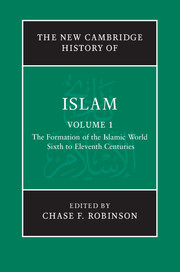Book contents
- Frontmatter
- Introduction
- PART I THE LATE ANTIQUE CONTEXT
- PART II UNIVERSALISM AND IMPERIALISM
- PART III REGIONALISM
- 10 Arabia
- 11 The Islamic east
- 12 Syria
- 13 Egypt
- 14 The Iberian Peninsula and North Africa
- PART IV THE HISTORIOGRAPHY OF EARLY ISLAMIC HISTORY
- Conclusion: From formative Islam to classical Islam
- Glossary
- Bibliography
- Index
- Plate Section
- References
12 - Syria
from PART III - REGIONALISM
Published online by Cambridge University Press: 28 March 2011
- Frontmatter
- Introduction
- PART I THE LATE ANTIQUE CONTEXT
- PART II UNIVERSALISM AND IMPERIALISM
- PART III REGIONALISM
- 10 Arabia
- 11 The Islamic east
- 12 Syria
- 13 Egypt
- 14 The Iberian Peninsula and North Africa
- PART IV THE HISTORIOGRAPHY OF EARLY ISLAMIC HISTORY
- Conclusion: From formative Islam to classical Islam
- Glossary
- Bibliography
- Index
- Plate Section
- References
Summary
Syria is a name, not a country. It comprises a vast region whose boundaries, political or ‘natural’, cannot be defined with any precision. The Arabs called it (and still do) al-Shām or Bilād al-Shām – literally, ‘the lands to the left’, i.e. to the north for a person in the Arabian Pninsula facing east towards the rising sun. In its broadest sense it is simply the western half of the Fertile Crescent, reaching north to south from the foothills of the Taurus and Anti-Taurus mountains to the Gulf of ʿAqaba and the Wādī Sirḥān, and east to west from the middle Euphrates to the Mediterranean. On the south, it fades imperceptibly into the great deserts of Sinai and the Arabian Peninsula. On the north, it adjoins the Cilician plain. The lands stretching from the Euphrates east and to the upper Tigris are both an extension of Syria and a separate entity. Usually called Mesopotamia – or, in Arabic, al-Jazīra – this region had, and still retains, a distinctive profile of its own, for it formed the frontier zone between Islam and Byzantium, and between the Kurdish and Armenian highlands on the north and the Arab-dominated lowlands on the south. Even so, western Mesopotamia/al-Jazīra is so deeply intertwined with Syria proper that it must be included in this chapter. Localism and political fragmentation were the inevitable consequence of Syria’s geography. Even so, the interaction between the region’s disparate elements was constant and intense.
Keywords
- Type
- Chapter
- Information
- The New Cambridge History of Islam , pp. 506 - 540Publisher: Cambridge University PressPrint publication year: 2010
References
- 1
- Cited by



